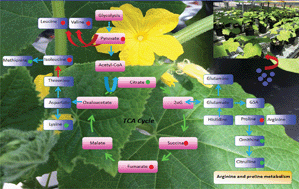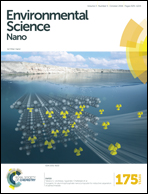GC-TOF-MS based metabolomics and ICP-MS based metallomics of cucumber (Cucumis sativus) fruits reveal alteration of metabolites profile and biological pathway disruption induced by nano copper†
Abstract
Copper-based nanoparticles have wide application in agriculture as fungicides and bactericides. Due to the rapid increase in their use, it is imperative to understand their environmental impact, especially on agricultural crops. In this study, inductively coupled plasma mass spectrometry (ICP-MS) based metallomics and gas chromatography-time of flight mass spectrometry (GC-TOF-MS) based metabolomics were applied to detect metal and molecular changes in cucumber plants exposed to various environmentally-relevant levels of nano copper (nCu at 0, 200, 400, and 800 mg kg−1) until full maturity. Metallomics studies showed nCu caused the perturbation of Fe uptake in leaves. In fruit, Ca, K, S, P, Zn and Mg increased after exposure to 400 and 800 mg kg−1 nCu. Metabolomics and partial least-squares discriminant analysis (PLS-DA) revealed that the metabolite profile in cucumber fruits was distinctively altered due to exposure to nCu. A number of metabolites were either up-regulated (proline, glycine, valine, pelargonic acid, arachidic acid, xylose, benzoic acid) or down-regulated (citric acid, myo-inositol, ornithine, 1-kestose) in response to nCu exposure. Biological pathway analysis showed a number of C and N related pathways were changed, especially galactose metabolism and the tricarboxylic acid cycle, indicating C and N metabolism was perturbed by nCu. This study showed GC-TOF-MS based metabolomics combined with ICP-MS based metallomics provide the necessary preliminary data to conduct further mechanistic investigations.

- This article is part of the themed collection: Sustainable Nanotechnology Organization 2015


 Please wait while we load your content...
Please wait while we load your content...